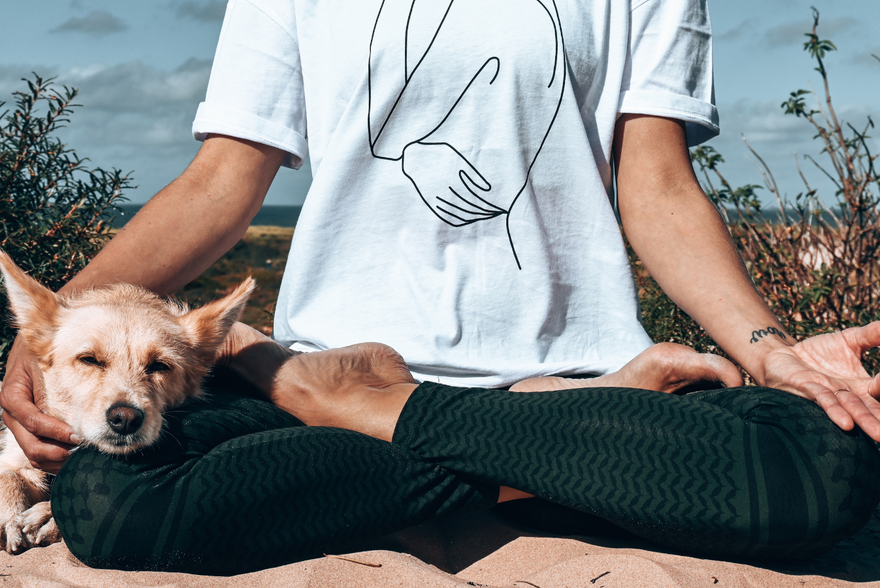With yoga exercises you can promote your mobility and flexibility, strengthen your body and improve your posture. Asanas - this is what the yoga positions are called - can be either static or dynamic. With static exercises you stay in one position for a while, dynamic exercises - called Vinyasa - combine individual yoga positions smoothly in harmony with breathing.
You can practice in the yoga studio, but just as well at home. All you need is comfortable yoga clothing and a yoga mat. We'll show you the best yoga exercises for beginners and advanced students so you can get started right away.
The best basic yoga exercises: the most famous asanas for beginners
Are you still a beginner and wondering which yoga exercises are suitable for beginners? Here we have the most popular yoga exercises that you can do at home as a beginner. You can also find further exercises and tips in this overview article especially for beginners
Warrior 1 (Virabhadrasana I)
Start in a lunge position with your feet and hips facing the beginning of the mat. The heel of the back foot is raised. As you inhale, lift your arms up and as you exhale, bend your front leg until your knee is aligned over your ankle. Keep your arms stretched, palms touching. After 30-60 seconds, switch to the other side.
With the warrior position you strengthen the leg and gluteal muscles in particular and the upper body is stretched.

Cat-Cow (Marjariasana)
This basic yoga exercise is e.g. B. often used to warm up in Hatha Yoga. It stretches and mobilizes your entire back. If you tend to have tension or pain in the back of your body, this exercise is a real relief!

The Triangle (Trikonasana)
With this posture you stretch the entire side of your body and open your chest.

The Tree (Vrikshasana)
Stand straight with your legs together. Extend your arms to the sides and shift your weight onto one leg. Bring the foot of the other leg to your upper or lower leg (not your knee). Reach your arms up or bring your hands in front of your heart, palms touching. Repeat the yoga position on the other side.
This basic yoga exercise trains your balance and ability to concentrate.

The Bow (Dhanurasana)
With this yoga exercise you open the chest and intensively stretch the abdominal wall as well as the arms and front thighs. At the same time, the spine is mobilized.

The Sun Salutation (Surya Namaskara)
There are different variations of the sun salutation. We'll show you the most common sequence of asanas:
- Mountain Pose (Tadasana)
- Stretched Mountain Pose (Urdhva Hastasana)
- standing forward bend (Uttanasana)
- half forward bend (Ardha Uttanasana)
- Downward-Facing Dog (Adhomukha Shvanasana)
- Yoga push-ups (Chaturanga Dandasana)
- Cobra (Bhujangasana) or Upward Facing Dog (Urdhva Mukha Shvanasana)
- downward dog
- half forward bend
- whole prevention
- stretched mountain pose
- Mountain stance
Which yoga exercises are suitable for advanced students?
Have you been practicing yoga for a while and would like to try some more difficult yoga figures? Then we have popular advanced yoga exercises for you here.
Warrior 2 (Virabhadrasana II)
Place your legs wide apart and extend your arms parallel to the floor. The back foot is positioned diagonally, the front foot points towards the beginning of the mat. Both heels are firmly on the ground. Bend your front leg until your knee and ankle are at the same height. Keep your back and entire upper body straight and then repeat the yoga position on the other side.
With the warrior position you strengthen your entire body, as well as your mental strength and stamina.

The Crow (Kakasana)
This yoga exercise requires a lot of tension and strength in the core of the body - and trains it. Hands and arms are strengthened and you improve your balance and concentration.

Headstand (Shirshasana)
The headstand is one of the supreme disciplines among yoga positions - but with a little practice you can definitely do it and it's worth it! To start, you can place your yoga mat against a wall to support your legs. With this yoga exercise you will strengthen your upper body and achieve greater physical and mental balance.

Yoga Positions: How Often Should I Do These?
To date, more women than men practice yoga - even though yoga is suitable for everyone. You can find out about the benefits of yoga for men in this article.
Anyone can do yoga. With our basic yoga exercises you can start your yoga practice!
